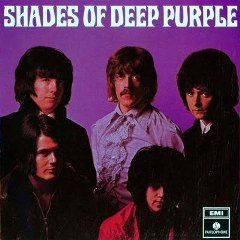Deep Purple – Shades of Deep Purple (1968)
Deep Purple – Shades of Deep Purple (1968)

01. And The Address (Ritchie Blackmore, Jon Lord) – 4:34
02. Hush (Joe South) – 4:21
03. One More Rainy Day (Rod Evans, Lord) – 3:36
04. a) Prelude: Happiness (Rimsky-Korsakov, Evans, Blackmore,
Nick Simper, Lord, Ian Paice) –
b) I'm So Glad (Skip James) – 7:15
05. Mandrake Root (Blackmore, Evans, Lord) – 6:04
06. Help! (John Lennon, Paul McCartney) – 5:57
07. Love Help Me (Blackmore, Evans) – 3:49
08. Hey Joe (Billy Roberts) – 7:23
Personnel:
- Rod Evans - lead vocals
- Ritchie Blackmore - lead guitar
- Nick Simper - bass, backing vocals
- Jon Lord - organ, backing vocals
- Ian Paice – drums
The usual perception of early Deep Purple is that it was a band with a lot of potential in search of a direction. And that might be true of their debut LP, put together in three days of sessions in May of 1968, but it's still a hell of an album. From the opening bars of "And the Address," it's clear that they'd gotten down the fundamentals of heavy metal from day one, and at various points the electricity and the beat just surge forth in ways that were startlingly new in the summer of 1968. Ritchie Blackmore never sounded less at ease as a guitarist than he does on this album, and the sound mix doesn't exactly favor the heavier side of his playing, but the rhythm section of Nick Simper and Ian Paice rumble forward, and Jon Lord's organ flourishes, weaving classical riffs, and unexpected arabesques into "I'm So Glad," which sounds rather majestic here. "Hush" was the number that most people knew at the time (it was a hit single in America), and it is a smooth, crunchy interpretation of the Joe South song. But nobody could have been disappointed with the rest of this record -- one can even hear the very distant origins of "Smoke on the Water" in "Mandrake Root," once one gets past the similarities to Jimi Hendrix's "Foxy Lady"; by the song's extended finale, they sound more like the Nice. Their version of "Help" is one of the more interesting reinterpretations of a Beatles song, as a slow, rough-textured dirge. "Hey Joe" is a bit overblown, and the group clearly had to work a bit at both songwriting and their presentation, but one key attribute that runs through most of this record -- even more so than the very pronounced heaviness of the playing -- is a spirit of fun; these guys are obviously having the time of their lives rushing through their limited repertoire, and it's infectious to the listener; it gives this record much more of a '60s feel than we're accustomed to hearing from this band. [The EMI/Spitfire re-release from 2000 is notably superior to any prior version of the CD, made from the original master tape (which had been sent directly to the group's American label, Tetragrammaton, leaving EMI with a vinyl dub, astonishingly enough), with textures far closer and crisper than have ever been heard before -- there are also five bonus tracks, two very early outtakes from their earliest sessions, an alternate version of "Help," a BBC recording of "Hey Joe," and a searing live U.S. television performance of "Hush."] ---Bruce Eder, AllMusic Review
Deep Purple sukces odniósł już kilka tygodni po sformowaniu pierwszego składu, kiedy to singiel z ich wersją "Hush" (przeboju Billy'ego Joe Royala, autorstwa Joe Southa) trafiła na czwarte miejsce w amerykańskich notowaniach, a na drugie w Kanadzie (w rodzimej Wlk. Brytanii zespół nie będzie zauważany aż do 1970 roku - wcześniej EMI/Parlophone skupiali się wyłącznie na promocji The Beatles). Kując żelazo póki gorące, Amerykanie wymusili na zespole jak najszybsze nagranie pełnego albumu. I dlatego właśnie "Shades of Deep Purple" jest płytą bardzo niedojrzałą, nie do końca przemyślaną.
Longplay w połowie składa się z cudzych utworów. Fakt, że zespół znacznie je pozmieniał, tak żeby nadać im własnego brzmienia. W przypadku wspomnianego "Hush" jest to tylko zaostrzenie brzmienia, ale już w przeróbkach "I'm So Glad" Skipa Jamesa i "Hey Joe" The Leaves (bardziej znanych z wykonań - odpowiednio - Cream i The Jimi Hendrix Experience) pojawiają się długie instrumentalne wstępy, inspirowane muzyką klasyczną (w "Prelude: Happiness", czyli wstępie do "I'm So Glad", pojawia się cytat z "Scheherazade" Nikołaja Rimski-Korsakowa, a w "Hey Joe" - z "Mars, the Bringer of War" Gustava Holsta). Natomiast beatlesowski "Help!", w oryginale bardzo dynamiczny, został przerobiony na spokojną balladę - czyli tak, jak pierwotnie miał być nagrany przez Wspaniałą Czwórkę.
Jeżeli zaś chodzi o autorski repertuar, to zespół kompletnie jeszcze nie miał pojęcia, co właściwie chce grać. "One More Rainy Day" i "Love Help Me" to piosenki niemal popowe. Z drugiej strony są tu takie utwory, jak instrumentalny "And the Address" czy niemal hardrockowy "Mandrake Root", zapowiadające kierunek, w którym zespół wkrótce podąży. Zresztą ten ostatni stał się obowiązkowym punktem koncertów w latach 1970-71, kiedy pierwszy skład Deep Purple był już historią. Na żywo "Mandrake Root" rozrastał się do kilkunastu minut, chociaż już w 6-minutowej wersji studyjnej sporą część stanowiły rozbudowane solowe popisy, o psychodeliczno-orientalnym zabarwieniu.
"Shades of Deep Purple" jest w dyskografii Deep Purple tylko ciekawostką, pokazującą początki grupy, ale nie mającą prawie nic wspólnego z jej dalszą działalnością. Kompaktowa reedycja zawiera niewykorzystany utwór "Shadows" (kolejny z prezentujących popowe oblicze zespołu), instrumentalną wersję "Love Help Me", alternatywne podejście do "Help!", "Hey Joe" z radiowej audycji BBC Top Gear Session, a także wersję "Hush" z bliżej nieokreślonego amerykańskiego programu TV. ---Paweł Pałasz, pablosreviews.blogspot.com
download (mp3 @320 kbs):
yandex mediafire uloz.to cloudmailru gett
Zmieniony (Środa, 17 Styczeń 2018 20:57)








